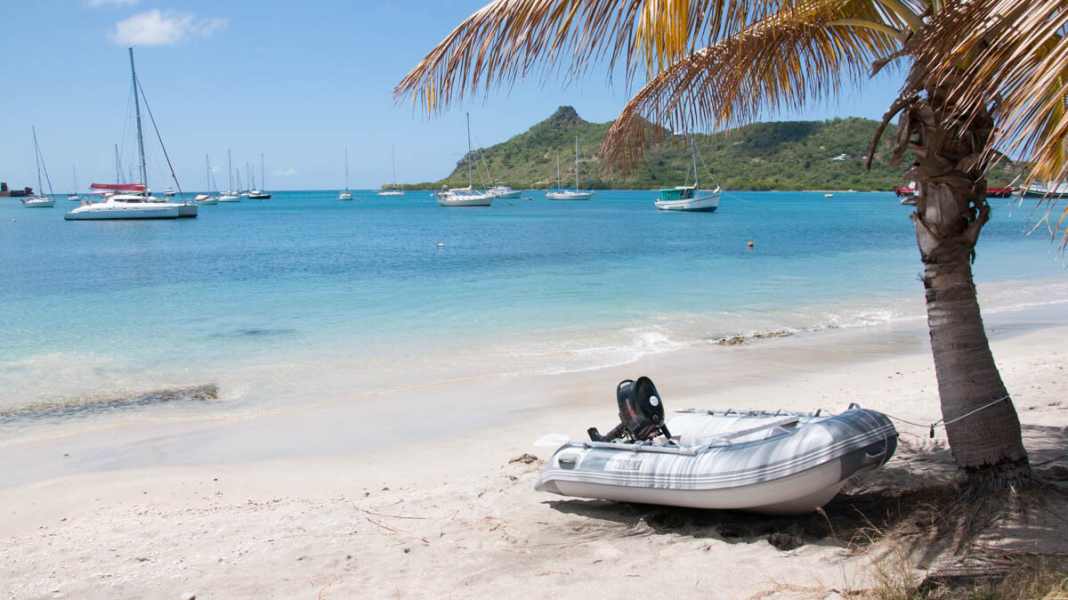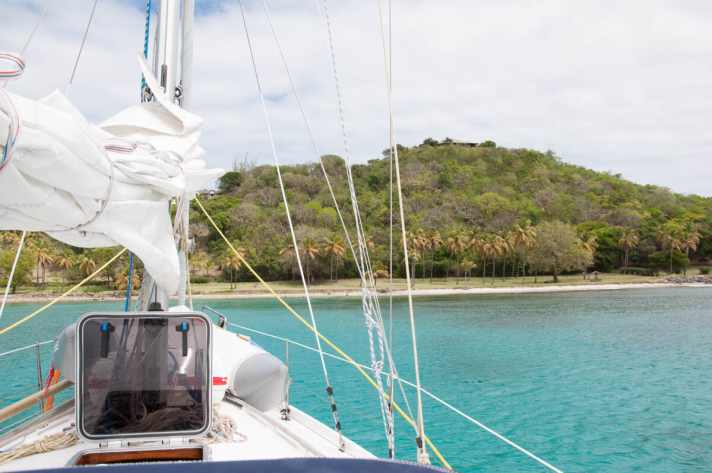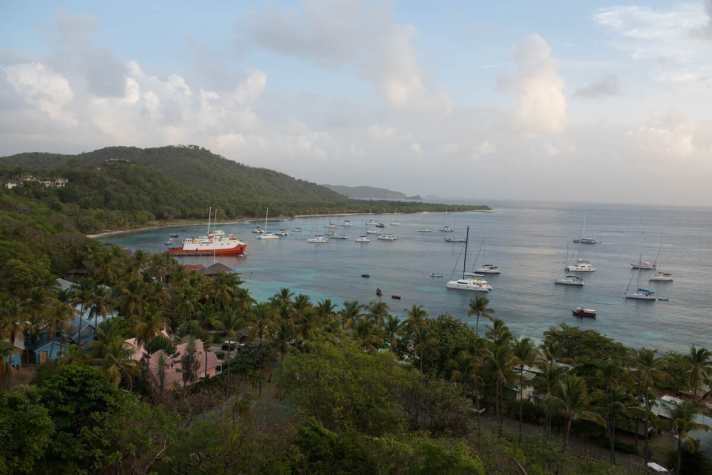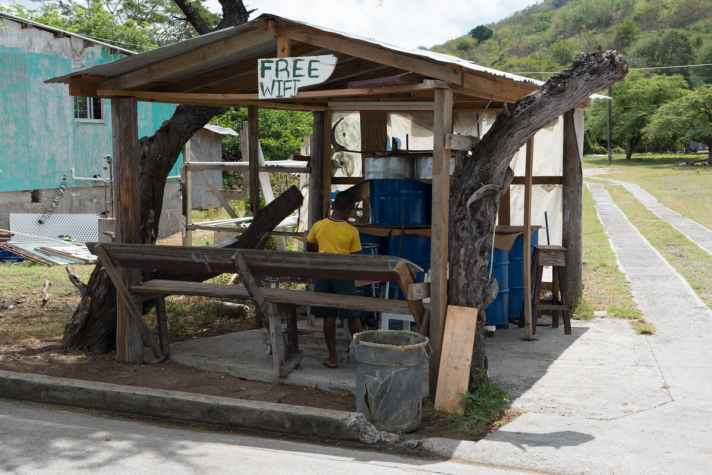
Wallilabou Bay on the Caribbean island of St Vincent, which served as the backdrop for the pirate headquarters in the film "Pirates of the Caribbean", was the scene of a brutal pirate attack a few days ago that is currently making headlines around the world. It sounds like irony, but unfortunately it is bitter reality.
According to the Prime Minister of St Vincent, Ralph Gonsalves, the attack took place at around 1.30 am. The ship was boarded by two armed assailants and the skipper and a crew member were injured by gunshot wounds. One crew member succumbed to his wounds shortly afterwards.
According to further initial information from a victim's friends, the attack must have happened very quickly: The intruders came on board and immediately shot at a crew member who was sleeping on deck. Two female crew members heard the shot and were about to rush on deck. When the first woman reached the bridge deck, she was hit on the head by the attacker, causing the second crew member to barricade herself in her cabin. The skipper was also shot; only after the attack could he be treated by the crew.
To the crew's surprise, the robbery went unnoticed by other anchormen and it took about half an hour for the police to reach the scene from shore and be taken on board by the crew in their own dinghy. When the Prime Minister was called in, an aircraft was immediately available to fly the crew back to Germany. They were only allowed to board the catamaran once more to collect their personal belongings and remove them from the ship in plastic bags. The crew are now back in Germany and have no idea where their belongings have gone or what actually happened a few days ago against the backdrop of the Caribbean palm trees.
If you leaf through brochures about Caribbean holidays, all you ever see are beautiful pictures of secluded beaches and bays with crystal-clear water. Boat shows and charter catalogues are also dominated by images of the Tobago Cays, the wonderful waterfalls of Grenada or the rainforests of Dominica. But the dangers are not mentioned.

Even the Federal Foreign Office warns of this on its website:
Sailors should be aware that robberies on ships at anchor or close to shore or cases of piracy occur sporadically in the Eastern Caribbean and should take appropriate measures (caution with spontaneous guests on board, self-protection at night). Emergency calls to the police/coastguard via 911 (mobile phone) may be more reliable than emergency calls via mobile marine radio.
While the Caribbean was primarily known for theft, pirate attacks seem to be on the rise. In December, there were two attacks on sailing yachts between Trinidad and Grenada, and in January there was an attack on a sailor off St Croix. In January 2014, the case of two Britons went around the world: they were attacked off St Lucia and the skipper was murdered. When we were in Grenada last year, I kept reading about a serial killer who ambushes tourists on the beach with a machete and kills them from behind on a sun lounger.
Reading all these cases raises the question of whether it is worth the risk to sail to the Caribbean.
However, it is not appropriate to speak of a trend at present. The Caribbean Safety and Security Net recently presented its statistics for 2015. It shows that there were a total of twelve cases of piracy (armed robberies) against sailors throughout the Caribbean that year, mainly at anchor. Only one attack took place in St Vincent and the Grenadines. In recent years, however, there have been repeated robberies in well-known hotspots such as Venezuela and Trinidad, as well as in Central America, such as the recent case of two German nature filmmakers who were robbed on their sailing boat in Bocas del Toro (near Panama) in September 2015. A statistic that initially suggests that the risk in the other Windward Islands is manageable.
However, if you ask long-distance sailors in the Caribbean about their personal impressions, the answer sounds different. Many are of the opinion that things are getting worse. Others are of the opinion that the crime rate is as high as it has always been, but that robberies and thefts are now publicised more quickly than before thanks to the media and Facebook.
Fortunately, robberies like the one last Friday on St Vincent are rare, but theft is more common. As far as the latter is concerned, the statistics are not to be trusted, as many cases are not reported. Last April, for example, we met two Dutch sailors on Bequia in the Grenadines who were attacked by locals the next day on their way back from the internet café to the dinghy, their rucksack containing their laptop and external hard drive stolen. It contained all the pictures from their three-year circumnavigation; there was no back-up.
Robberies and thefts often occur at dusk or at night. To make the anchorages a little safer, patrol boats are deployed at many hotspots and make their rounds at regular intervals. However, what sounds like a major safety advantage is actually rather sobering in reality: Most of them are former, worn-out fishing boats with a rickety outboard motor and spray-painted "Ranger" lettering, on which locals with torn T-shirts drive around between the anchored boats. Personally, the sight of these boats didn't really put us at ease.

When I arrived in Rodney Bay on St Lucia with my little "Maverick" in February 2006, aged 20 at the time, I met the local Ricky on the very first day. I exuberantly told him how happy I was to finally be at the destination of my dreams and how great I thought the Caribbean was. "Is this your first time here?" he asked me and immediately added a few basic rules with a serious face: "If you sleep on board at night, always lock everything up properly. And when you're ashore, only carry as much money as you need. Don't carry a wallet, but spread the notes all over your body in different pockets. It's not safe here."
Of course, that surprised me a little at the time, but it didn't intimidate me. I always felt safe there for the whole two months. It was only months later, when I was already in the USA, that I learnt that a young Dutch couple had been attacked shortly after my departure, in the middle of the lagoon in Rodney Bay, where there was still an anchorage at the time. Today the jetties of the marina are there. The couple anchored their ten metre long boat and were attacked at night. After collecting everything of value, they tied up the skipper and raped his wife. When I read this in the USA, a cold shiver went down my spine - in my two months at anchor there, it felt so safe. I never thought something like that could happen. Shortly afterwards, sailors and Rodney Bay Marina joined forces and bought a patrol boat for the anchorage, or so I was told at the time.
Sailors who have been travelling in the Caribbean for many years will give you the usual tips as a newcomer: large, sturdy locks in front of the companionway and a sturdy locking system from the inside. Many sailors have customised bars or grilles made for companionways and deck hatches, as the standard plastic locks are easy to lever out. Also: chain everything that is not bolted to the boat, not just the dinghy, but also the outboard motor and tank. Never leave the dinghy in the water, but winch it on deck every evening. Not only for theft reasons, but also to give burglars less chance of getting on board.
The majority of night raids happen unexpectedly out of the water, swimming. When we reached Admiralty Bay on Bequia last year, sailors advised us to anchor on the northern side of the large bay. "As far away from the beach as possible so that you can't be reached by swimming."

No matter how positively you go through life, you shouldn't ignore the warnings, robbery and theft stories, and a certain amount of worry always accompanies you. We felt very comfortable and safe in most places and anchorages. But that feeling can change quickly. Like on Carriacou in the Grenadines, for example. We anchored far off the coast, went ashore during the day, bought fresh vegetables from a farmer and chatted to the locals. In the evening, there was a party with reggae music in a beach bar, which we could still hear from the anchorage. The lively locals had a lot of fun and sang along. A typical Caribbean feeling; we enjoyed being part of it from afar. We went to bed at around 11 p.m. and left the hatch over the forward berth open to fall asleep in the warm trade winds.
When we woke up again three hours later to incredibly loud music, the atmosphere on land had changed. The reggae music had given way to ganster rap, with lyrics singing about various drugs. The locals were drunk or under the influence of drugs, shouting aggressively at each other and throwing things around. We thought: What if they get the idea to go out on the water for a few dollars? All of a sudden, we no longer felt comfortable at all and locked the deck hatch and even the smallest window.
On our journey north, Swiss friends even sailed past the coast of St Vincent at a distance of 15 miles because they had been told that there had been attacks with speedboats.
We also sailed past - and are still a little annoyed about it today. Did we let the other sailors give us too many worries? The view of the mountainous island at dusk was stunning. Five miles off the coast, we could smell and taste the rainforest in the heavy air and marvel at the clouds hugging the mountains. Just before sunset we passed Wallilabou Bay, scene of the recent raid. I had always wanted to go there, but it was always too dangerous for me.

Is it an exaggeration to keep such a distance from dangerous areas? After all, the probability of being attacked is relatively low, especially for us with a small boat. In most cases, charter yachts are attacked and we miss out on a lot of experiences with the country and its people, which is why we are here.
We love the Caribbean. Cati especially Union Island, me Grenada. Nevertheless, we have now discovered the Bahamas for ourselves and love them even more. It's not just because the islands are more secluded, but because they are much safer.
Why is that? I think it's mainly because the gap between rich and poor is not as great as in the Windward Islands. There are big millionaire mansions here and there, but in the Bahamas the locals are much better off financially. Most of them have well-paid jobs and the crime rate is much lower.
Nevertheless, the Caribbean island world has a very different, special flair - not least due to its unique nature. Even if the reports about piracy and theft sound so negative: I think the Caribbean is still worth a trip and we will be sailing there again. But it's important to observe a few rules, maintain a healthy scepticism and keep a little distance.
Above all, take precautions, as Ricky advised me to do at the time. For me, this includes avoiding dark alleyways and secluded places on land and only carrying as much money as necessary. Always anchor offshore out of the reach of swimmers, with bars in front of the hatches. Bring the dinghy on deck at night. That way you can sleep more peacefully.

